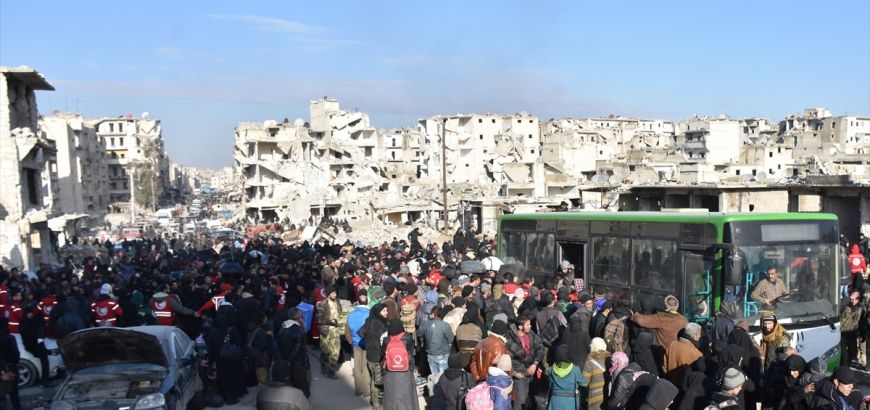* Written by a group of displaced Syrians from the Zabadani area at the Syrian Association for Citizen’s Dignity
At the beginning of April 2017, the “Four Towns Agreement” – in its amended version – was signed between representatives of some opposition factions on the one hand, and Iran and its proxy militia, the Lebanese Hezbollah, on the other hand, under the coverage of the Syrian regime yet in isolation from the United Nations, who was present in the first signed version. Yet when the second version was signed, it disregarded the obligations of the Syrian regime and Iran in the first version, which included releasing a large number of detainees (1500 detainees) and not forcing the residents of the region to leave their homes.
This agreement resulted in the forcible displacement of a large number of residents of Al-Zabadani[1], including residents of Al-Zabadani, Madaya and Baqin. On the other side, the residents of the towns of Kafraya and Al-Foua, which are located within the areas controlled by the Free Army factions, were displaced. Iran, the country directly implicated in the crime of displacement along with the regime, has also made sure to include other cities and towns in the agreement in the north and south of the country.
This displacement was not the only product of this political agreement, but also the siege and starvation policies pursued by Hezbollah at the border, in addition to the indiscriminate bombing of civilians, which played a major role in forcing the people and the factions in those areas to leave their towns and cities. This siege and bombardment resulted in the death of more than 300 civilians, 84 who died of starvation.
Hezbollah’s intervention in the Zabadani area was evident since mid-March of 2015, as it sought to control the area due to its strategic location and its importance to the Iranian project, because the Zabadani area is a mountainous region whose western foothills overlook Lebanon and its eastern foothills overlook the capital, Damascus. As such, Hezbollah embarked on systematic steps to tighten its siege and grip on the city of Al-Zabadani and the neighboring town of Madaya, starting with the leveling of lands and burning hundreds of fruit trees and extending secondary roads through agricultural lands, all the way to planting belts of mines in the plain and around Al-Zabadani and Madaya in particular. This eventually led to the siege of Al-Zabadani town after controlling more than eighty percent of the administrative borders of the Zabadani area, which includes, in addition to the city of Zabadani, the towns of Madaya, Baqin, Waheesh Bajd, Sargaya, al-Rawda, Deir al-Ashayer, and the villages and towns of Wadi Barada.
The strategic importance of the Zabadani region for the Iranians was demonstrated by the fact that the Syrian regime was completely distanced from the plans to control the region, as Hezbollah managed the blockade and military operations on the ground, while Iran managed the negotiations to reach one of the most important demographic change processes that the country witnessed after the displacement of Qusayr, also adjacent to the Lebanese border, where Iran and Hezbollah were heavily involved as well.
On the other hand, Iran forced the people of the two Shiite towns of Kafraya and Foua – which mostly support it and its ally, the Assad regime – to be displaced completely after completing the displacement of Madaya and Zabadani in about a year. This shows that the Syrian regime and its allies, Russia and Iran, have adopted a policy of demographic engineering of the country by adopting the policies of siege, starvation and military escalation in the areas revolting against it, which led to the displacement of hundreds of thousands of people from their areas, as it became clear that Hezbollah intended to intensify pressure on civilians, whether through siege or military escalation, down to subjugating the local population to making concessions to them. In fact, Hezbollah not only imposed a siege of death on Madaya, and caused the displacement of more than 5,975 people, but also imposed policies that prevented civilians from returning to their areas in the future. It established more than 250 military outposts and, after the displacement, paved the secondary roads in the plain and the mountain to facilitate the transfer of weapons and drugs between Syria and Lebanon.
Hezbollah also turned the area into a large warehouse for weapons coming from Iran, which was later bombed by Israel. This led to the dismemberment of the plain and the destruction of hundreds of long-lived and non-durable fruit trees, which need replanting alternative trees and fruition for at least ten years. In addition to the damage to the agricultural land itself and the need to reclaim it again. Not to mention converting several hectares of agricultural land in the vicinity of Madaya and Zabadani to minefields, which makes the process of land reclamation and cultivation fraught with fatal risks. Pumping stations and electric power generations were also destroyed, and more than 80 percent of the urban area of Al-Zabadani was demolished.
All this and more make the logical hope and objective opportunity for a dignified and safe return for the people of the region, even in the absence of the political and security conditions to achieve a safe environment, almost non-existent with the lack of livelihoods and income opportunities for a society that works mostly in agriculture, not to mention the collateral damage. The environmental destruction and changing the features of the region with its picturesque nature, which was deliberately executed by Hezbollah, has deeply impacted the investment opportunities for the people in the tourism and real estate sectors, in addition to a sharp decline in commercial activity, especially in the town of Madaya, as a result of the decline of tourism in the region.
The regime in Damascus bears legal, moral and political responsibility for the crimes of starvation, siege, and forced displacement specifically in Zabadani and Madaya, not to mention denying citizens a dignified, safe and voluntary return. This is based on its legal jurisdiction over the region in the first place, and also its subsequent investment in the crime of forced displacement and the continuation of its policies in preventing the dignified, safe and voluntary return of the displaced. In addition, the Syrian regime also tampers with people’s properties and livelihoods and blackmailing them through its brokers to give up their properties, while it confiscates the properties of the displaced and those who refused military service under the regime’s army.
For this reason, the displaced people of Zabadani do not see any return reasonable or acceptable under the current circumstances. The safe return can only happen if there was reparation and compensation for the harm and loss the people endured, as well as the establishment of a safe and neutral environment, preceded by confidence-building measures such accountability for those who committed crimes and were involved, whether they are local or foreign officials, and the release of the detainees and reveal of the fate of the disappeared.
[1] Al-Zabadani area includes: the city of Al-Zabadani and a number of cities, towns and villages.



